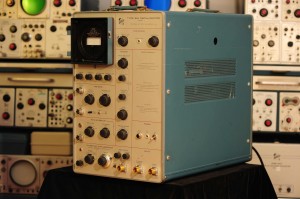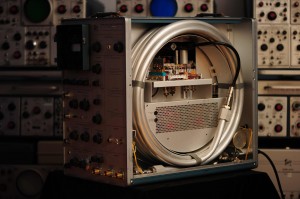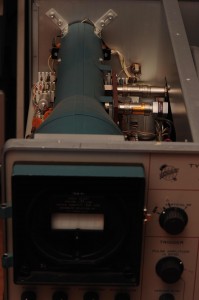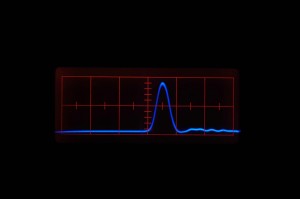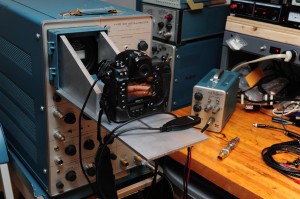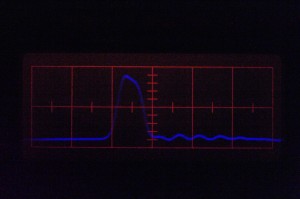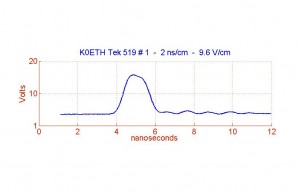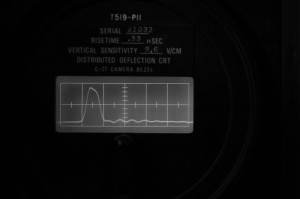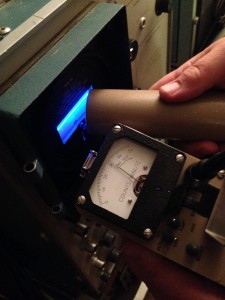The Tektronix 519 Oscilloscope is one of my favorite instruments. It is generally not useful as it has a fixed vertical “gain,” and an uncommon 125 Ohm input impedance that uses special 125 Ohm (gold colored) General Radio connectors, which requires a sequence of properly impedance-matched connectors to provide a standard N or BNC connector. The motivation for the oddball connectors must have come from specifications of the then AEC as I have even noticed a chain for adapters hanging off 519s pictured in historic Tek literature.
I own two 519s, both came from the Los Alamos Black Hole surplus store for $30 each. I drove them and a Tek 555 across country on my way back to the east cost. As soon as I was back home, I began to dig into them and start restoration. Much to my surprise, neither 50+ year-old 519 required any work and both were found to still be in calibration.
Outside of its limitations, the 519 an amazing instrument in many ways. Perhaps the neatest feature boasts 1 GHz bandwidth accomplished by bringing the input signal directly to the deflection plates of the CRT. This makes the 519 the first direct reading 1 GHz scope (as opposed complicated and finicky sampling oscilloscopes). They are part of the transmission line. No middleman of an amplifier chain to limit the high-frequency response. About one half of the cabinet houses a fixed delay line, which can be seen coiled up between the front-panel input connectors and the input to the CRT. A ferrite loaded pickup, just behind the front panel, located at the beginning of the delay line, initiates the trigger circuitry for the CRT horizontal sweep. The delay line, as the name suggests, delays the signal’s arrival at the CRT.
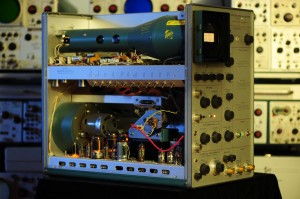
A close up, note the two lines of RF plumbing going into the right side of the CRT. At the very rear of the CRT sits a 25 keV electron gun. This is a fairly high accelerating voltage for a CRT, which is typically more like 10 keV. The signal to be measured enters the CRT in the rear coaxial line, and travels toward the phosphor end of the CRT. The 25 keV electron beam enters the deflection channel, travels parallel to the unshielded high frequency pulse/signal transmission line, and incurs a vertical kick. At the end of the transmission line/deflector, the signal propagates back out of the CRT and terminates in the 125-ohm load. After the beam has left the deflection channel, it is allowed to drift ~ 20 cm so as to permit the deflection to become pronounced. Since there is no vertical amplifier chain, what you see is what you put in…. fixed vertical scale – any scaling comes from external amplification or attenuators.
The signal enters the scope, passes through the trigger circuitry (which starts the CRT writing), then goes through the delay line (so the CRT writing can catch up), then finally enters the CRT. The following is an example of a 800 picosecond (FWHM) pulse from my Tek 109 pulse generator. The scope’s horizontal time base is set to 2 ns/div.
The above is a repetitive signal, however, because of the special blue P-11 phosphor screen which provides a light which photography is very sensitive to, single shots image captures are possible. Sometimes you only get one pulse – consider the initial client and from whom I purchased these. If the scopes could talk, I am sure they saw some very interesting cold-war history. It is very difficult to obtain and process film for the Tek C-50 scope cameras today, so I did the unthinkable and broke authenticity by making my own scope camera, using the very low-light sensitive Nikon D3s.
With this camera, I was able to capture a single shot of the same 800 psec pulse:
Beyond restoring and admiring this Cadillac of Oscilloscopes, I have had the need to make fast-rise time, high voltage, single shot EMP measurements. The sort of measurement that I would never bring a state of the art digitizing scope near, but without trepidation I was successful with my trusty 519 ! “Data Thief” is a fantastic program that permits the digitizing of images.
Each CRT was slightly different, and had to be characterized and its gained uniquely stamped on the bezel. his one had a vertical sensitivity of 9.6 V/cm.
An interesting observation, such high accelerating voltages will produce x-rays. I was able to measure about 3,ooo CPM with the CRT at full intensity.
